One of the first things you will need to do as a digital marketer is a marketing audit, whether you are joining a new company within an in-house position, starting work with a new client at your marketing agency, or starting a new website for you to run on a freelance basis.
This process is vital. Get it right, and you will be well on your way to bringing in more customers and revenue. If you get it wrong, you could spend time (and money) in the wrong places, leading to wasted efforts and negligible results.
When you properly conduct a marketing audit and make the right decisions based on this, you can expect exceptional results, as shown in the screenshot below, which shows SEOTesting’s traffic growth over time.

In this article, we will explain what a marketing audit is and how to conduct one for your business. This will be a convenient guide for those new to marketing or who must complete their first marketing audit.
So, let’s get right into it.
What is a Marketing Audit?
A marketing audit is a report that is done to analyze the current state of your marketing. The audit aims to help you identify where your marketing is working well and where it needs improvement. Once complete, it will help you create a plan to improve your overall marketing.
A marketing audit, when done correctly, will help you answer the following questions:
- Are my marketing objectives clear and aligned with our business goals?
- Is the marketing plan doing well in reaching the target audience?
- How well does our company understand its market and its customers?
- What are the strengths and weaknesses of our current marketing tactics?
- How competitive is our business in the industry compared to competitors?
- Are we correctly utilizing our marketing mix elements? Product, price, place, promotion.
- What are the biggest opportunities we currently have with our marketing?
- What are the biggest threats/challenges we are currently facing?
- How efficiently are we utilizing our marketing budget?
The goal of your marketing audit should be to answer all of the questions above in a way that everyone within the business can understand, whether they work in marketing or not. You can also include other questions that are specific to your business.
By the time you have finished your marketing audit, you should be able to show anyone within your business where your marketing is working, where it requires improvement, where your marketing budget is being well-utilized, where any budget needs to be allocated or re-allocated and the top-performing channels for your business.
Of course, depending on the business, other questions may need to be asked and answered. For example, SaaS businesses like ours will have different targets than e-commerce businesses. But the basic principle remains the same.
Who is Responsible for Performing a Marketing Audit?
Depending on your business’s specific situation, the person creating and conducting a marketing audit will differ. Generally, however, three prominent people/roles will take this on:
- A CMO/head of marketing or other marketing manager.
- An agency account manager.
- A freelance marketing contractor.
In this section, we’ll discuss the specific situations in which each of the people/job roles listed above may be required to undertake a marketing audit.
CMO / Head of Marketing
If your business has an in-house marketing team, performing a marketing audit will usually fall on the person in charge of this marketing team. For most companies, this will be the CMO or the head of marketing, but depending on the company’s size, it could also fall into the marketing manager’s job role.
This is an easy decision, as whoever is in charge of your business’s marketing will also control the decisions made and the money spent. That way, once the marketing audit has been completed, funds can be allocated to your marketing department’s correct personnel or teams to give your business the best chance of success.
Agency Account Manager
If your business works with a marketing agency, your marketing audit will usually be performed by the agency’s account manager. This way, they can give you an overview of your marketing and allocate the funds you pay to the agency to give your business the best chance of success.
For example, if you are working with an agency, and they discover that your paid advertising needs improvement, they may choose to allocate more of your budget for the coming weeks and months to improve this. This gives more time for the agency’s paid advertising team to come in and do their work.

SEOTesting’s ‘Brand vs. Non-Brand’ report can help you establish which part of your marketing agency needs to perform your marketing audit. For example, if your website performs well with brand traffic but needs more work with non-brand traffic, SEO and paid acquisition teams must be involved.
Freelance Marketing Contractor
In some cases, businesses with an internal marketing team and businesses that choose to work with a marketing agency may hire outside help from a freelance marketing contractor to complete a marketing audit.
Why?
In many cases, it can be helpful to have ‘outside’ eyes on your marketing strategy, which can bring in fresh ideas. It’s also worth noting that there are freelancers out there who specialize in creating and completing marketing audits for a variety of business types. Hiring people like these, even if only on a one-time basis, can be incredibly beneficial to your business.
Sometimes, businesses and agencies who work with companies need to remove their rose-tinted glasses and allow someone with no stake in the business to tell them what is working with their marketing and what is not.
What is the Difference Between a Marketing Audit and a Marketing Plan?
Sometimes, ‘marketing audit’ and ‘marketing plan’ are used interchangeably… While similar terms, they describe separate but equally important documents.
What is a Marketing Audit?
A marketing audit is a comprehensive overview of your business’s marketing performance. It will highlight areas where your business is doing well with its marketing while also highlighting areas of concern. Not only that, it will also go into detail about competing companies and how they are performing versus your business.
What is a Marketing Plan?
A marketing plan, on the other hand, is a document that outlines your business’s entire marketing process. It will outline the whole timeline for your marketing strategy, detail what channels your business will utilize, how each channel will work, and where the budget needs to be spent.
When Should You Perform a Marketing Audit?
In this next section, we will outline the different scenarios in which your business may need a marketing audit. These include when an agency begins working with a new client, when you start working with a new company as a freelance contractor, and when your marketing strategy has been in operation for approximately six months.
Beginning Work with a New Company (In-House)
Suppose you are a marketing employee, or your company has just hired a new marketing employee, especially if they are in a managerial position. This would be the right time to perform a marketing audit.
New people bring new ideas, so conducting a marketing audit here is a great way to establish where these new staff members believe your current marketing is working and where it could be improved. It’s commonplace for the first task a new marketing hire completes to be a marketing audit.
From here, decisions can be made on the level of new investment needed, new channels to explore, and new strategies to experiment with.
Beginning Work with a New Company (Agency)
If your company has decided to sign up with a new marketing agency, then it is more than likely that the first task they perform for you is a marketing audit. Depending on the agency’s workflow, they may have already performed one during bidding.
The USP that many marketing agencies possess is they have a team of experts in almost every single marketing field ready to take on more work. If, during the audit, it’s established that your business needs more help with its paid advertising and link building, the marketing agency can distribute more billable hours to this kind of work. Suppose these areas are significant and do not require much additional work. In that case, funds can be split evenly across the agency’s different departments for a more well-rounded approach to your business’s marketing.
When Redesigning your Marketing Plan
It’s common for companies to choose to change their marketing direction. This change could have been sparked by a new product offering, a merger or acquisition, new marketing hires within the team, or the emergence of new competitors.
Whatever the reason for the change, it’s always advisable to complete a marketing audit whenever you wish to change the direction of your company’s marketing efforts significantly.
When a Marketing Plan has Run for 6 Months
The biggest pit your marketing strategy can fall into is stagnation. While it is a true statement that doubling down on what works is one of the best ways to grow, it’s also true that if you do not adapt to changes when they happen, your business will fall behind.
Because of that, it’s important to complete a marketing audit regularly throughout your business’s lifetime. The exact cadence will depend on your business, competitors, and the marketing channels in which you invest the most time and effort. For example, if you invest much time and money into a paid acquisition, you may wish to audit more frequently.
If you put more time and energy into content creation, you should regularly audit your content marketing. For most businesses, the rule of thumb is to audit your entire marketing strategy every six months.
How to Conduct a Marketing Audit: The Step-by-Step Guide
To round off this blog post, we will take you through the seven steps you need to follow to conduct a marketing audit for your business. We’ll go through the following:
- How do you decide what you need to audit?
- Why it’s essential to agree on goals and KPIs.
- How to build customer personas.
- How to identify your competitors.
- How to gather your data.
- How to analyze your data.
- What are the next steps once all this has been completed?
Deciding What to Audit
The first step of any marketing audit is deciding what to audit for your business.
While some businesses may feel that they only need to audit one particular channel, such as their content marketing or their PPC campaigns, completing a full marketing audit is beneficial. This audit will cover all of your business’s existing channels and any new channels the company could utilize. Completing a marketing audit of this scale will be helpful as it will help you decide what hires need to be made, where the budget needs to be allocated, and what channels to sunset.
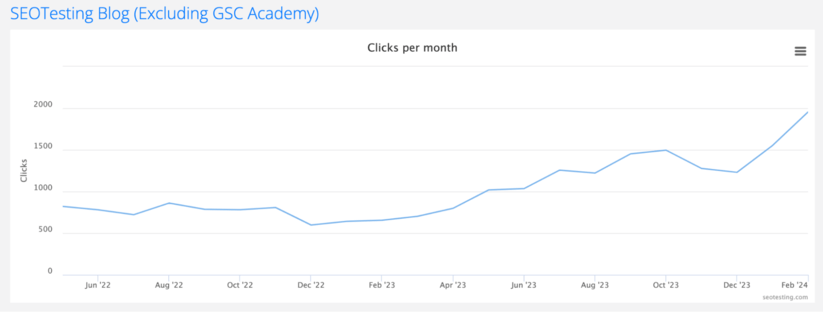
SEOTesting’s ‘Content Group’ feature can help you decide which sections of your website need to be audited to improve them. Not all of your website’s content will perform at the same level, and some sections will work much better.
Sometimes, it’s worth noting that what you audit will depend on your business’s state. If you are working with a brand-new company, you will need to audit every marketing channel to establish where you will have the most success. If you are completing a six-month audit, you may decide only to audit the marketing channels you are actively targeting.
For example, if you actively spend time, energy, and budget on content creation, paid acquisition, and social media marketing for your business, then you should only be auditing these channels.
Agreeing Goals & KPIs
The next step of your upcoming marketing audit is to decide on the goals and KPIs on which you will judge your marketing.
Regardless of the industry or the company size, all businesses will have different goals and KPIs on which they judge their success.
Using SEOTesting as an example, we track our performance against these metrics:
- Monthly Recurring Revenue (MRR)
- Annual Run Rate (ARR)
- Number of Leads Monthly
- Organic Traffic
Of course, we track others, but the above are the main metrics we want to track. We will then set individual goals for each of these metrics.
Focusing on these metrics and goals will help us decide whether our marketing channels are performing below, at, or above expectations. For example, as we have organic traffic goals to hit, we must ensure our content marketing is doing its job. So, as part of our marketing audit, we will need to perform a content audit.
Building Ideal Customer Profiles
Once you have decided what your business needs to audit and agree with stakeholders on the goals and KPIs you need to be judged on, you need to create or update your ideal customer profiles.
An ideal customer profile, also called a buyer persona, is the profile of your business’s ideal customer or set of customers. For a company like SEOTesting, we have a few different buyer personas:
- One customer type we target is someone who runs a marketing agency, is looking for a handy way to track client organic performance, and wants to save time when conducting analysis.
- One customer type is someone who works for themselves, such as a marketing consultant. They have a small number of clients and are looking for ways to save time when analyzing client performance and finding quick wins.
- We also want to ensure we are targeting in-house SEOs, people who spend a lot of time working with Google Search Console who want to save themselves time in their day-to-day work, and marketers who want to find new ways to work with GSC data.
- Finally, we also target people who run their content websites, as we have a range of GSC-based reports that will allow them to find new content ideas quickly and easily without the need for time-consuming spreadsheet analysis.
But how do you create an individual customer profile for your business?
Conduct Market Research
You need to start by gathering data on your existing customers and the market you target. You can collect helpful information through surveys, customer interviews, and online behavior analysis. You should also examine customer demographics, behavior patterns, motivations, and goals.
Identify Customer Goals and Challenges
You then need to work to understand what drives your customers. What are their goals and objectives, and what obstacles do they face to achieve them? This information will help you amend and build your product or service offerings to meet their needs.
Analyze Your Findings
Analyzing your findings is a crucial step. Look for common characteristics and trends in the data collected about your ideal customers. This information will include age ranges, interests, job roles, industries, places they spend time online, and who they speak to on social media sites. Here, you are looking for patterns that help you define who a typical customer is for your company.
Create Segmented Personas
Based on your above analysis, segment your audience into distinct personas. Each persona will represent a significant portion of your audience with similar characteristics. This is why businesses often have multiple buyer personas to denote different customers.
Detail Each Persona
For each persona, you now need to create a detailed profile that includes:
- Demographic information.
- Goals.
- Challenges.
- Preferred communication channels.
Give them a name and even a fictional biography to help make them more relatable to your marketing and sales staff. This can be done as a spreadsheet, but some companies like to create PDFs that can be distributed to new and existing employees.
Tailor Your Marketing & Messaging
Use the insights you have gained from your personas to tailor your marketing messages, product development, and customer service. Your goal is to address your personas’ specific needs, challenges, and desires.
Identifying Competition
The next step in your marketing audit is to identify your competitors. This step is vital as you need to understand the businesses you are competing with while also establishing whether your marketing is working as intended or whether more efforts need to be made.
Sometimes, budgetary decisions are made simply because new competitors have emerged and been identified. This is precisely what will have occurred in the marketing departments at ‘Generative AI’ tools like Jasper, Copy.ai, and Writesonic will have done when ChatGPT entered the mainstream market, especially since ChatGPT does have a free service that does not require a monthly subscription.
Think of your competitors as a yardstick to measure success. Of course, in most examples, companies will be doing better than you simply because they have a much larger headcount and marketing budget, but this doesn’t mean you can’t compete with them in some ways.
SERP Competitors vs Business Competitors
When establishing your competitors, it’s also critical to identify your SERP and your business competitors.
SERP competitors are businesses you regularly compete within the SERPs when publishing and updating new content.
In contrast, business competitors are businesses you compete with in other areas, such as social media, traditional advertising, and offline marketing, such as advertising boards. Not every competitor is a SERP competitor, so identifying both sets of competitors is crucial.
Gathering Data
The next step of your process will be gathering the data you can use for your marketing audit.
You will need to gather data in different areas, and this section will discuss how to do it for each step.
Extracting Data from Google Search Console & GA4
The first step in extracting your relevant data is to log into Google Search Console and GA4. These contain essential information about how your business is performing online.
If you are also targeting Bing, you can use Bing Webmaster Tools. However, this post will focus on Google Search Console and Google Analytics.
To extract your organic search data from Google Search Console, first head to your GSC dashboard and click on the “Search results” tab on the left-hand side toolbar:
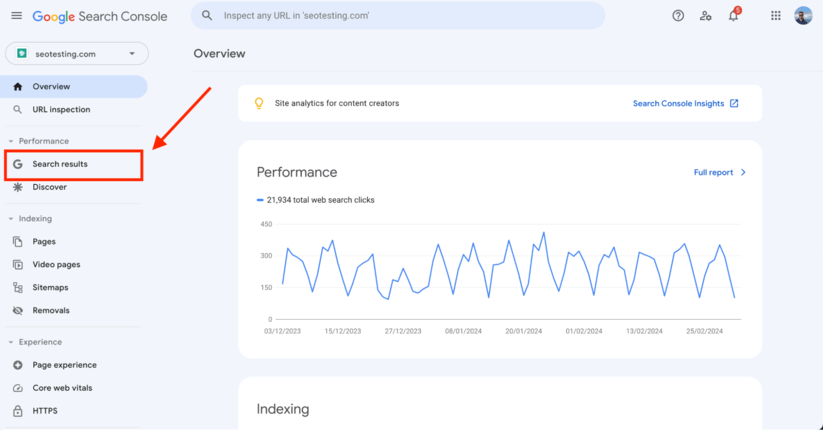
You can extract this data if your business gets regular traffic from Google Discover.
The next step is to select the date range you want for your data. GSC only holds data for up to sixteen months, so this is the maximum date range you can extract.
Since we are conducting a six-monthly audit, we will take all of our performance data from the past six months:
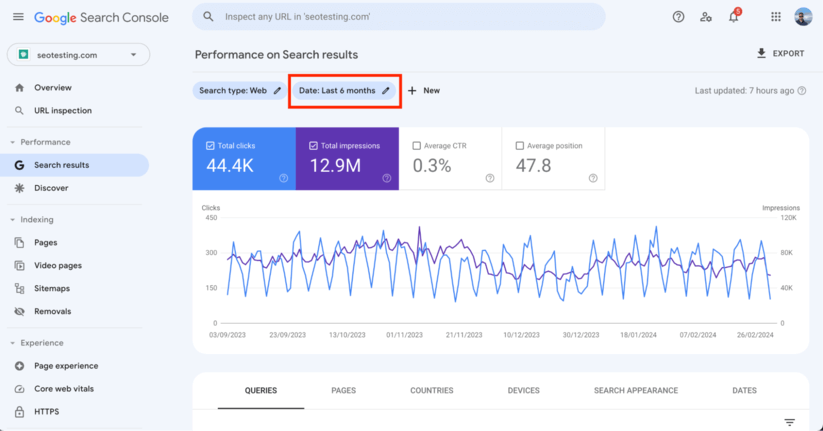
Finally, we need to export this to access it via a spreadsheet. To do this, simply ensure the Average CTR and Average position buttons are selected and showing on your graph, then click the EXPORT button on the top-right-hand side of the screen:
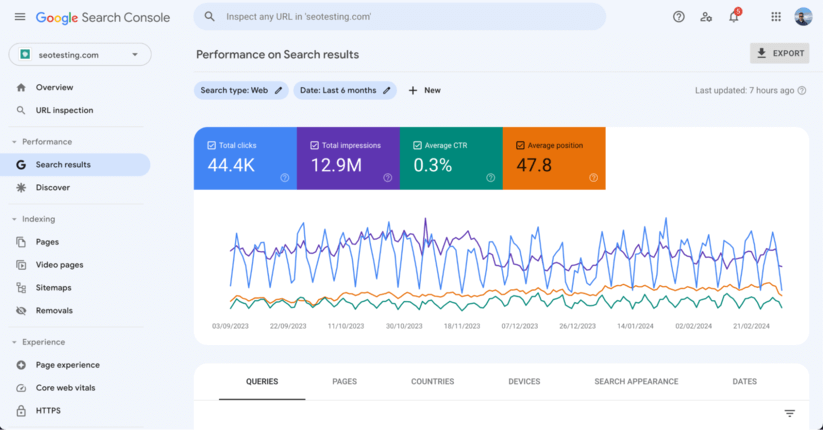
You’ll now have a spreadsheet containing raw performance data, which is great for content and marketing audits. You can export this data to Google Sheets, download it in an Excel format, or download it as a CSV file.
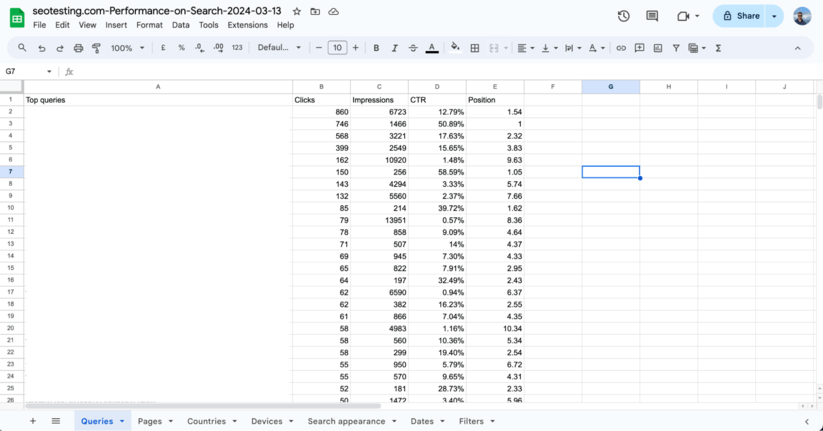
You now need to do the same thing for GA4. The difference is that GA4 will also contain data for other marketing channels, such as referral, paid, social media, and direct traffic. So, you must decide whether to focus on one channel or take the data as a whole.
You’ll want to ensure all data is included for a general marketing audit. If you were doing an organic marketing audit, you’d just need the organic performance data.
Downloading the raw data from GA4 is a little more complicated than GSC, but it can be done. You must do this on a “report by report” basis, meaning you must download each report separately.
For this blog post, we’ll focus on our User Acquisition Report from the last six months:
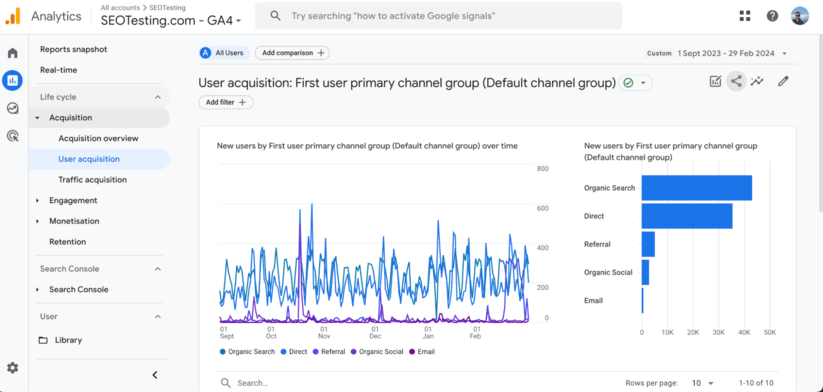
This report contains all relevant data on how SEOTesting acquired users between September 1st, 2023, and February 29th, 2024.
To download this, we simply need to click the share button within the report:
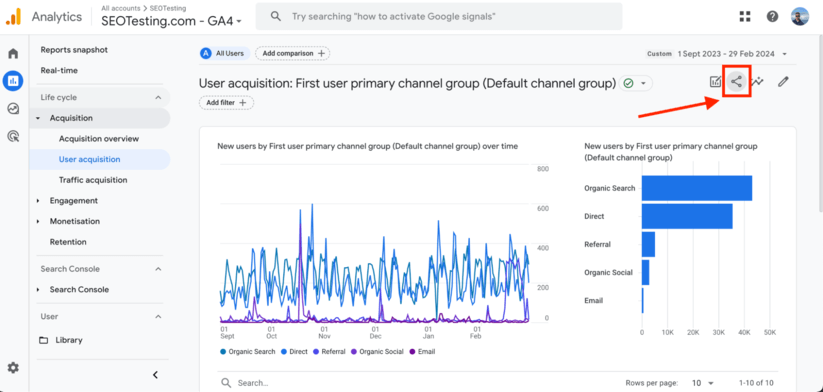
Next, we need to choose to download the report:
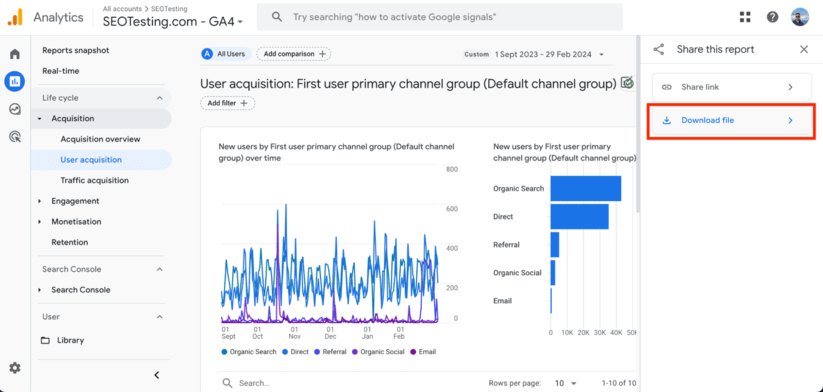
We will be given the option to download the report as a PDF or CSV file. We’ll download it as a CSV report for raw data extraction. This will provide us with a spreadsheet that looks like this:
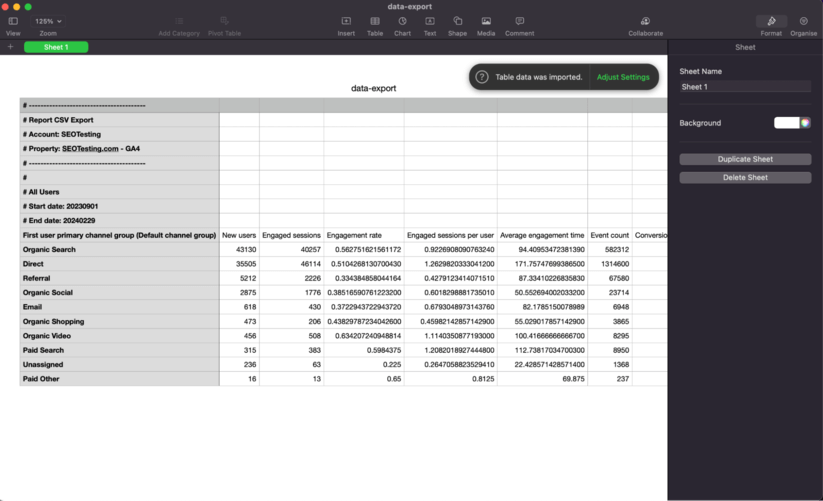
Extracting Data from External Tools
The next step is to include data from external tools such as:
- Ahrefs
- Semrush
- Moz
- SERanking
Or another marketing suite of your choice. For this example, we’ll use Ahrefs as we pay for a subscription. However, the steps are incredibly similar no matter what third-party tool you use.
First, we’ll head into the ‘Site Explorer’ tool within Ahrefs, type in our domain, and click search. This will give us a screen that looks something similar to this:
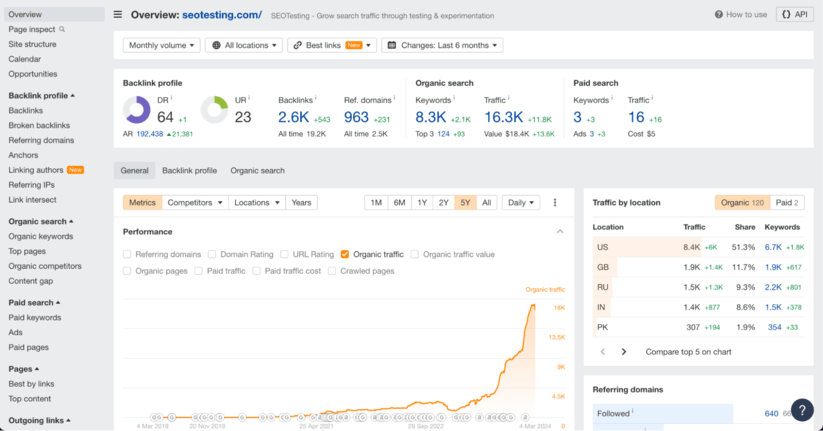
Look at the toolbar on the left-hand side of the screen; this is where we can drill down into more specific information. For a marketing audit, we’d recommend looking at the following:
- Backlinks
- Organic keywords
- Top pages
- Organic competitors
- Content gap
This will all be tailored for organic search. If you are also looking to include paid search in this audit, then you can take a look at other reports within Ahrefs, including:
- Paid keywords
- Ads
- Paid pages
As we did with Google Search Console and GA4, we now need to export the relevant reports. We’ll focus on the ‘Backlink’ report as the example here.
Head into your backlink report, so you are given a screen looking like this:
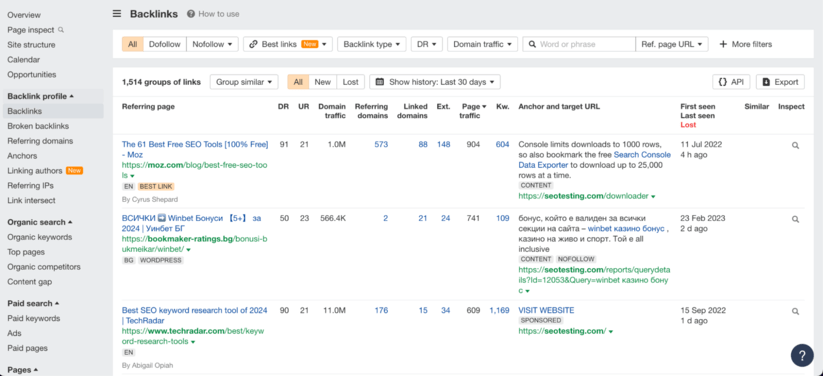
Head to the top-right corner of the screen and select the ‘Export’ button:
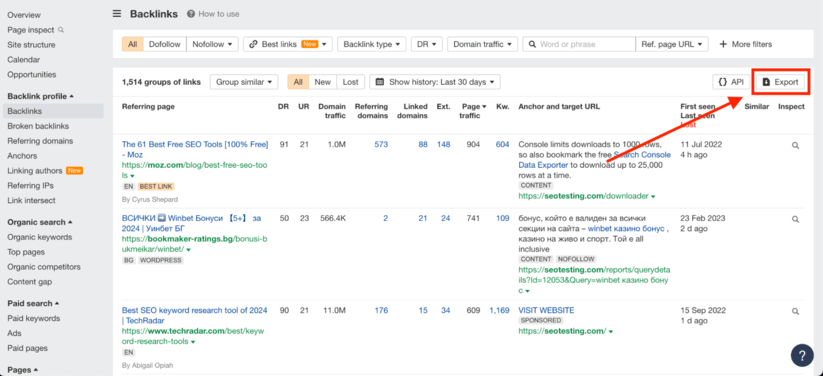
From here, you’ll be able to download the raw data for this specific report:
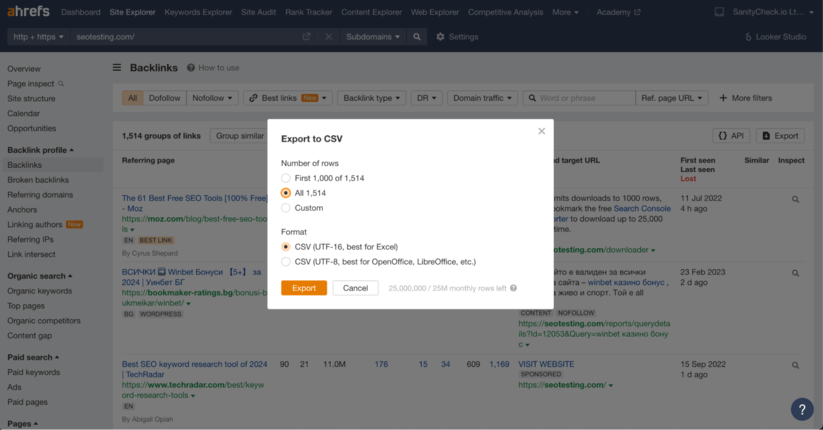
Click export, wait for the export to complete, and you’re all done. You must do this for all the separate reports you wish to include in your marketing audit.
Side Note: Using third-party data like this is fine, but just keep in mind that this is third-party data and will not be as reliable as first-party data that you will find in Google Analytics and Google Search Console. So, take any traffic and traffic value measurements with a pinch of salt.
Gathering Customer Data
The next step is to gather all of your specific customer data. Your business will have a wealth of information about customers who are already using your products or services or prospective customers interested in using your products or services. This data is invaluable when conducting a marketing audit. It will help you make better marketing decisions based on data, leading your business to tremendous success.
The process of extracting your customer data involves a series of steps, starting with identifying all of your different data sources. You need to find where all of your customer information is stored. Common places include:
- CRM systems.
- Website analytics.
- Social media analytics.
- Email marketing software.
- Sales records.
This stage sets the foundation for the data collection process.
Following the identification of these sources, you need to collect customer data. The goal is to capture a broad spectrum of data, ranging from quantitative aspects like purchase history and website engagement metrics to qualitative insights from customer surveys, reviews, and comments on your social media accounts. This approach ensures you have a proper dataset that reflects both the actions your business is taking and your customers’ sentiments.
You must comply with data protection regulations, including the General Data Protection Regulation (GDPR) in the EU or the CCPA in the USA. These regulations have strict guidelines for collecting, storing, and using customer data. You also need to secure proper customer consent before collecting their data.
Gathering More Specific Data
To finalize the data collection process, you can also get access to more specific data that will be tailored to your company. For example, if your business runs a lot of ads, then it is worth venturing into your different ad accounts, including:
- Google Ads
- Facebook Ads
- Twitter Ads
- LinkedIn Ads
- Bing Ads
To download all of your ad-specific data.
So now you are at a stage where you have collected all of your data. What then?
Auditing the Data
Once you have gathered all of this customer data, the next step within your marketing audit is to analyze the data to draw actionable insights.
This stage is where the value of your marketing audit comes to light. It involves a deep dive into the data you have collected, comparing and contrasting it against various benchmarks and historical data to identify trends, opportunities, and areas that require more attention and improvement.
Comparing Results Against Past Campaigns
One of the best analyses you can perform is comparing your current data with that of past campaigns. This comparison allows you to see how your current efforts are performing and how your strategies have evolved.
For example, your recent email marketing campaign resulted in a higher open rate than previous campaigns. This shows that your subject line strategies or audience segmentation are becoming more effective. On the other hand, if you notice a decline in engagement or conversion rates, it may signal areas that need to be re-evaluated or adjusted.
Analyzing Data Against Industry Benchmarks
Another crucial aspect of auditing your data involves comparing your metrics against industry benchmarks. This comparison gives you a sense of where you stand within your industry, highlighting your strengths and weaknesses.
If your conversion rates as an ecommerce company are higher than the industry average, your product offerings or marketing tactics are working well with your target audience. However, if your website’s bounce rate exceeds industry norms, it may indicate user experience issues or a mismatch between customer expectations and what your website delivers.
We just mentioned finding industry norms to establish how your business compares. Luckily, this is a relatively easy process. You can do this by scouring industry reports published by companies such as Forrester and Nielsen, using ‘benchmarks’ features in software such as ChartMogul or others, and participating in industry forums with people who own similar businesses.
Considering Changes in Search Behavior
Marketing is constantly changing. Search is always evolving. Paid advertising is continually changing. Analyzing how shifts in search trends and behaviors may impact your marketing efforts is crucial during your marketing audit.
This analysis could involve examining changes in the keywords driving traffic to your website, the rise or fall in demand for specific products or services, or alterations in how people connect with and interact with your brand online.
Understanding these shifts can help you adapt your marketing strategies to better meet your audience’s needs.
Bringing It All Together
Auditing your data by comparing it against past campaigns, industry benchmarks, and changes in search behavior offers a bird’s-eye view of your current marketing plan.
These different data points work together to provide a detailed picture of your marketing effectiveness, revealing areas where you work well and need improvement. This holistic view helps you change and adapt your marketing strategies, ensuring they are data-driven and aligned with your business goals and the evolving landscape of customer behavior.
Finalize Next Steps
Finally, you need to finalize the next steps you will take.
Following your marketing audit, you will have raw data outlining how your business is currently performing, you will have access to different industry benchmarks you can compare your performance to, and you will have access to new and improved buyer personas to target, not to mention your goals that you will use to measure your success.
The following (and final) step is to bring it all together and make decisions.
You can use your organic performance statistics to decide whether to increase your publishing cadence, conduct additional analysis before work on new content starts, or explore new avenues for content publication.
Your business may need to start investing in new marketing channels, reducing the budget for existing channels, or abandoning them altogether.
For example, if your audit highlights that your business has spent £100,000 on ad campaigns in the past six months but has only yielded £120,000 in new sales, whereas your content marketing campaigns for the last six months have cost £50,000 and generated £200,000 in new sales, then you may wish to stop paid advertising altogether and putting this budget into new content creation.
Wrapping Up
This blog post has explained what a marketing audit is and how to conduct one. We’ve also discussed the initial steps to realizing why a marketing audit is necessary to gather and analyze data.
We have also highlighted the importance of a marketing audit in its ability to steer a business towards its objectives, ensuring that time and money are channeled effectively for the best impact.
A marketing audit is not ‘just’ a task to be checked off a list; it is an ongoing strategy that keeps your marketing efforts aligned with the dynamic and ever-changing nature of the market.
It requires concentration, a keen eye for detail, and the willingness to adapt based on the insights gained. By comparing your results against past campaigns, analyzing data against industry benchmarks, and considering changes in search behavior, you better understand your marketing performance.
These insights allow you to make informed decisions, whether to refine your target audience, adjust your marketing channel mix, or reallocate your budget to more productive channels altogether.
Ready to elevate your marketing strategy with data-driven insights? SEOTesting will be a crucial tool in your stack for conducting thorough marketing audits that uncover the strengths and weaknesses of your current efforts. Dive deep into your organic performance, identify quick wins and opportunities for growth, and measure your success against previous months and years. Sign up today for a free 14-day trial.

